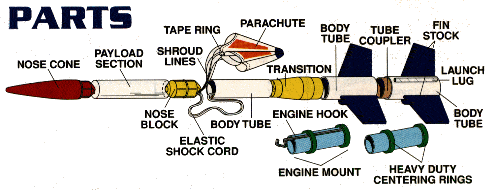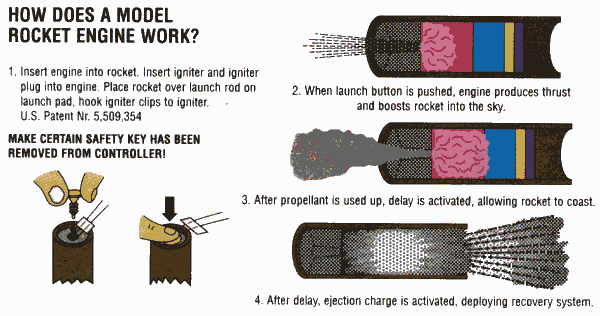Getting Started in Model Rocketry
What is a Model Rocket?

Getting Started
I would highly recommend a starter set if you are thinking about rocketry. Estes makes a new line of ready built starter sets, so there’s no excuse to wait anymore! They usually cost around £25-£40, depending on which rocket kit you choose. then all you need to buy is batteries and some engines.
Engines

What size engines to buy and what all the numbers mean is usually what confuses people the most. It’s actually not that confusing. In the instructions of the rocket kit you buy, it should say what size engines to buy. As for what all the numbers and letters mean, it’s pretty easy.
Lets take the “A8-3” engine for an example. The “A” represents the total impulse of that engine. Impulse letters for Estes model rockets stop at D, other companies make M engines or bigger !, Anyway, The “8” portion signifies the average thrust, measured in Newtons. Finally, the “3” section stands for the time delay of the ejection charge.
The ejection charge is what will push the recovery device out of the rocket.
For Example:
- A B6-4 engine has a 4 second time delay.
- A C6-3 engine’s average thrust is 6.
The numbers and letters continue on like so. The most common engines are 1/2A, A, B, C, and D.
As for what an engine is, well, read ahead. Model rocket engines are solid fuel propellant motors. The Estes engines use Black Powder.
On one end of the engine is a strong clay nozzle. The nozzle focuses the escaping gases for more power. At the other end of the engine is a clay cap. The cap ensures that all the pressure goes in one direction and not out the back. The cap gets blown off when the ejection charge fires. The whole engine is then wrapped in many layers of paper to create a strong cylinder open on both ends.
There are three sizes of engines (common ones anyway). First there’s 13mm which is the mini or 1/2A sizes. Mini engines are indicated with a “T” after the code. Next there’s 18mm or standard size. These are the A, B, and C engines. The last common type of engine is the 24mm which is the D sized engines.
A Rocket’s Flight

Recovery Devices
The recovery device is what will bring your rocket down to the ground safely after a flight. The type of recovery device depends on the size and weight of the rocket. Some rockets can use two types of devices, and it’s up to you to choose one.
The most common type of recovery device is the parachute. A properly sized parachute will bring the rocket down slow and gentle. One bad thing about the ‘chute, though, is that they drift in the wind, which could be bad if you have trees in your field. The next common type of recovery is a streamer. A streamer is just a long piece of material (usually crepe paper or plastic). The whole point of a streamer is to create drag in the air to slow the rocket down a little. Steamers don’t often drift and are usually more accurate. There are also two types of recovery for tiny rockets. They are Tumble and Feather-weight recovery. The engine is not held in place and ejects itself at apogee. The rocket then tumbles or falls to the ground.
Then there are some uncommon types of recovery devices. Some rockets use helicopter veins to slow the descent down, other rockets use gliders or are gliders themselves.
Rockets fall into 3 main categories
Performance or Sport Rockets
Some performance models reach 1 kilometre in altitude and speeds of Mach 1.3 (1,000 m.p.h.).
They accelerate 0-60 m.p.h. in 0.035 seconds in a distance of 24 inches! What else home made can you make which goes this fast under its own steam?
Scale Rockets
Scale models are of models of real Rockets and Missiles
There are scale models of the Space Shuttle, and the large Saturn 5 rockets and many others
Also there are scale models of well known missiles such as the Sidewinder and Hellfire
There is also models of famous Sci-Fi space ships, including the U.S.S. Enterprise and a Klingon Bird of Prey
Special Effect Rockets
Special effects machines may helicopter back, glide, deploy parachutists or glitter effects, carry payloads such as eggs or electronic devices, carry small cameras – still or video, measuring equipment such as altitude measurers, in fact the only limit is your imagination.
Rocketry Terms
- Apogee
- The highest point in a rocket’s flight.
- Blast Deflector
- A metal plate used to divert flame and gasses away from the engine.
- CATO
- CAtastrophic Take Off – when the rocket “explodes” on the pad
- CG
- Centre of Gravity- or where the rocket balances
- Cluster
- When more than one engine is used simultaneously to boost the rocket.
- Ejection
- The point when the rocket deploys the recovery system.
- Igniter
- A piece of wire that receives electricity from the launch controller to light the engine.
- Launch Controller
- An electrical device that is used with an igniter to light a rocket engine.
- Launch Lug
- a small tube that guides the rocket up the launch rod.
- Launch Rod
- A rod that guides the rocket until it gains enough speed for its fins to be effective.
- Lawn Dart
- When a rocket doesn’t eject it’s recovery device and dives to the ground.
- Multi-Staging
- When two or more engines are used in sequence to boost the model to higher altitudes.
- Mylar
- a thin, silvery, plastic-like material generally used in party balloons. This material packs very small and is good for streamers and parachutes.
- RSO
- Range safety officer - person who is in control of the launches and recovery of rockets on-site.
- N.A.R.
- National Association of Rocketry (main organisation for rocketry in the U.S.A.)
- Payload
- A object carried by the rocket during flight, e.g. a Camera.
- U.K.R.A.
- United Kingdom Rocketry Association
- Wadding
- A flame resistant cloth that gets packed in between the parachute and the engine. This protects the parachute from getting burned.

